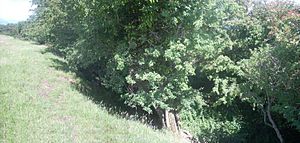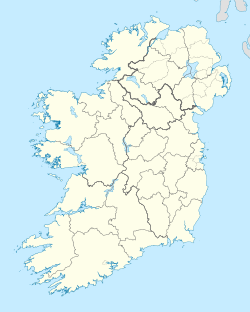Dún Ailinne facts for kids

A view of the ditch
|
|
| Alternative name | Dun Aulin |
|---|---|
| Location | County Kildare, Ireland |
| Coordinates | 53°06′54″N 6°46′30″W / 53.115°N 6.775°W |
| Type | Ancient ceremonial site |
| Area | 13 hectares (32 acres) |
| Height | 183 metres (600 ft) |
| History | |
| Material | Earth, timber |
| Periods | Iron Age–Middle Ages |
| Cultures | Gaelic |
Dún Ailinne (sometimes called Dun Aulin) is an old, special place on a hill called Cnoc Ailinne (Knockaulin) in County Kildare, Ireland. It's found southwest of Kilcullen, close to the N78 road that goes to Athy. It's a big round area that covers most of the hilltop, about 13 hectares wide. Today, you can't see much on the ground. But archaeologists have dug there and found that long ago, during the Iron Age (around 400 BCE to 400 CE), there were big round wooden buildings or rings of tall wooden posts inside this area.
According to old Irish mythology, Dún Ailinne was one of the most important royal sites in early Gaelic Ireland. People in the Early Medieval period believed it was where the Kings of Leinster were made kings. However, these stories were written long after the site was used. So, we don't really know how much it was connected to kings from that later time. Dún Ailinne is similar to other famous royal sites like Tara (for the Kings of Meath), Navan Fort (for the Kings of Ulster), and Rathcroghan (for the Kings of Connacht).
The site is on private land, so you can't just visit it. The hill is 183 meters (600 feet) above sea level. This means you can see it from many places nearby. The best view of Dún Ailinne is from the Old Kilcullen churchyard. This churchyard is free to visit and has an old round tower too. Don't mix up Dún Ailinne with the Hill of Allen (Cnoc Alúine), which is to the northwest.
Contents
What is Dún Ailinne?
Dún Ailinne is a large, round area about 13 hectares (32 acres) big. It has a bank of earth and a ditch around it, like a "henge". With most henges, the ditch is on the inside. This means it was probably a special or symbolic place, not a fort for fighting.
People think Dún Ailinne was a royal center. It was likely used for special ceremonies or to make new kings of Leinster. It's like the other royal sites such as Tara, Navan Fort, and Rathcroghan. This is because of its special use, the buildings inside, and its location.
When Was it Used?
The first signs of people using Dún Ailinne are from the Neolithic period (New Stone Age). But most of the activity happened during the Iron Age. It seems people didn't live there all year round. Instead, they used it for short periods, often for special events or rituals.
Archaeologists found signs that people stayed there during the spring and summer months. They also found lots of animal bones from cows, sheep, pigs, deer, and horses. This shows that people cooked and ate a lot of food there. A special sword and Roman brooches (pins) were also found at the site.
Dún Ailinne is mentioned in some old stories. But it was mostly left empty around the 6th century. This was about the time a new Christian settlement started nearby at Old Kilcullen.
What Buildings Were There?
Archaeologists dug at Dún Ailinne between 1960 and 1970. They found that there used to be wooden buildings inside the big round area. There were three main times when new structures were built. Each time, they built rings of tall wooden posts.
One of these building times, called the "Rose phase," had a shape like the number eight. It had one large ring and a smaller part attached to the south. It also had a fancy entrance shaped like a funnel.
Later, during the "Mauve phase," people built a wooden fence (stakewall). Inside this fence, there was another wooden ring and a smaller, closed round building. The last time the site was used, people had big ceremonial feasts. We know this because of the huge amount of animal bones found there.
How Do We Study Dún Ailinne?
A team from the University of Pennsylvania studied Dún Ailinne from 1968 to 1975. This team was led by Bernard Wailes. More recently, a new survey was done using special equipment to look underground. This survey found many new things hidden beneath the surface. We don't yet know exactly what these new features are.
In 2007, a book about Dún Ailinne was published. It was written by Bernard Wailes and Susan Johnston. In 2008, a special information spot was opened in Nicholastown, near Kilcullen. It has signs in both Irish and English. It also has a small model of the mound with a sculpture on top.
Visiting Dún Ailinne Today
The entire Dún Ailinne site is on private farmland. It can be hard to visit because of farm animals like cattle. If there are cattle on the hill, you cannot go there. However, if there are no cattle, you might be able to ask the landowner for permission to walk around the site.


